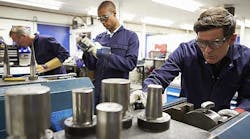President Trump’s promise to restore American manufacturing jobs contributed to his successful campaign. But now that he is in the White House, how should this administration best fulfill its promise to strengthen U.S. manufacturing?
Indeed, the United States runs a manufacturing trade deficit of $630 billion, and closing it would create many manufacturing jobs. Yet many pundits’ dismissive responses have ranged from “this is totally trivial” to “it will never work,” “picking winners only reduces economic welfare,” and “we shouldn’t care about manufacturing.”
But the carping has provided little substantive guidance for the incoming administration on what a practical and effective U.S. manufacturing strategy should look like. This shouldn’t be surprising; the Washington establishment and the broader community of neoclassical economists have no real idea what to do other than fall back on general framework measures such as reforming the tax code, training workers, and building physical infrastructure. Nor do they even offer an analysis of what caused the decline of U.S. manufacturing.
The Trump administration has an opportunity to get manufacturing policy right by ignoring both supercilious criticism and tired laissez faire thinking, but it also runs the risk of overreacting and thereby making things worse, not better. Indeed, there are concrete actions the Trump administration can take to revitalize U.S. manufacturing, fulfilling his promise to voters who put him over the top in vital swing states like Michigan and North Carolina, both of which lost over 40% of their manufacturing jobs from 2000 to 2009.
But first, it’s important to understand what happened to U.S. manufacturing in the early 2000s. A recent report from the Information Technology and Innovation Foundation (ITIF) found that despite the prevailing narrative that automation was the main culprit behind the loss of more than 5 million manufacturing jobs from 2000 to 2010, trade pressure and faltering U.S. competitiveness were in fact responsible for more than half of those job losses.
While U.S. GDP grew, output fell in 12 of 19 manufacturing subsectors. Simultaneously, other nations, especially China, ramped up their mercantilist polices—from currency manipulation to forced intellectual property transfers and government subsidies—all of which hurt U.S. manufacturing employment.
The fact that so many pundits and economists blame automation is because government statistics significantly overstate manufacturing productivity growth. Government data shows an astonishing 179% increase in computer manufacturing output from 2000 to 2010. But companies actually produced fewer computers domestically during this time, not more. The discrepancy is explained by the fact that the massive growth in productivity represents increasing computer processing speeds, not more computers.
The resulting mismeasurement significantly skews manufacturing statistics overall. Indeed, after removing computer and electronic products, it turns out that real value added from U.S. manufacturing grew just 6.4% from 2000 to 2015, not the reported 19.3%.
Moreover, manufacturing decline did not stop at the end of the Great Recession. Since 2010, manufacturing jobs have rebounded slowly while productivity growth has stalled, growing just 1.5% from 2012 to 2016, compared to 24% from 2002 to 2006.
And the manufacturing trade deficit has ballooned by 53% since 2010. So even with modest employment growth, the U.S. manufacturing sector remains on shaky footing.
Policy Recommendations
So given the need, how should President Trump go about fulfilling his promise to make U.S. manufacturing great again? There is no shortage of actual policy tactics, including from ITIF. What is in short supply however, is a vision for what an overall strategy should look like. Currently there are two main approaches in contention: do nothing and let the “market” work or use a blunderbuss of tariffs and compulsive policies to force companies to bring any and all jobs back. Neither represent real strategies for success.
A recent ITIF report offers a new approach, detailing 10 key principles to guide the Trump administration’s manufacturing strategy. I discuss three key components here.
First, President Trump should focus on high value-added, defensible sectors. Not all manufacturing sectors and functions within sectors provide the same value. Some industries and occupations are more important than others. For example, the annual median wage in the apparel, textile, and leather goods manufacturing industries is $24,000 to $29,000, while in the petroleum and coal products industry it is $63,000 and in the computer and electronic products industry it is $64,000.
This means that fighting to keep any and all industries from leaving the United States through steps such as stiff import tariffs would lower, not raise, U.S. living standards, because it would spur the growth not just of higher-wage industries, but also lower-wage ones. In contrast, more targeted policies to encourage more production in middle- and higher-wage industries, which the Carrier deal in Indiana represents, would increase U.S. living standards.
Second, enticing American—and even foreign—manufacturers to create or maintain manufacturing production in the United States represents a laudable goal, but one that’s best pursued by following an “attraction” strategy, which emphasizes implementing a coordinated set of public policies relating to taxes, high-skill talent, technology, trade, regulations and competition, finance, and digital and physical infrastructure, rather than a “compulsion” strategy.
Policies that threaten or force firms to make particular location decisions are far inferior and less effectual than these constructive policy initiatives that can help make America the world’s most attractive manufacturing environment—for domestic and foreign manufacturers alike. It’s one thing to use strong measures of trade enforcement to pressure nations to roll back their mercantilist policies; it’s quite another to use them to emulate the mercantilists.
Third, the U.S. manufacturing strategy should be broader than working on individual deals with particular firms because the extent of the challenge is too great for a piecemeal, scattershot approach. The administration should not emulate a “shoot anything that flies and claim anything that falls” approach (as one leading North Carolina economic development official described his state’s approach in 1980s).
Moreover, deals can’t be just about lowering costs and reducing regulations. U.S. manufacturing costs are already lower than Canada, France, Germany, Japan, and the United Kingdom, and are actually almost on par with those of Korea.
Low Cost, High Impact Tactics
If the Trump administration implements that strategy, here are a few tactics it should begin with that are low cost and high impact. It should push for legislation such as the 2016 “Made in America Manufacturing Communities Act,” a no-cost bill that designates “Manufacturing Communities” to assist regions in thinking strategically about how they fit into emerging industries and value chains and where they can be competitive.
Likewise, the president should champion the Export-Import Bank, an important component of the fabric that supports American manufacturing competitiveness.
Moreover, President Trump should push to increase funding for the Manufacturing Extension Partnership, which raises the technical and innovation capacity of America’s small- to medium-sized manufacturers.
He should also seek to expand Manufacturing USA, a public-private partnership network of innovation institutes that are focused on U.S. leadership in advanced manufacturing. Finally, he should quickly implement the newly enacted Manufacturing Universities program.
In short, it’s time to change the narrative that U.S. manufacturing jobs are being lost to robots in a rapid shift to high-tech “factories of the future” that pushes U.S. manufacturing output to an all-time high. This kind of Pollyannaish thinking keeps policymakers from focusing on what is really needed: a robust U.S. manufacturing strategy. It appears that President Trump recognizes this. The whole country hopes that he gets it right.
Adams Nager is an economic policy analyst at the Information Technology and Innovation Foundation (ITIF) , science and tech policy think tank. Robert D. Atkinson is ITIF’s founder and president.




